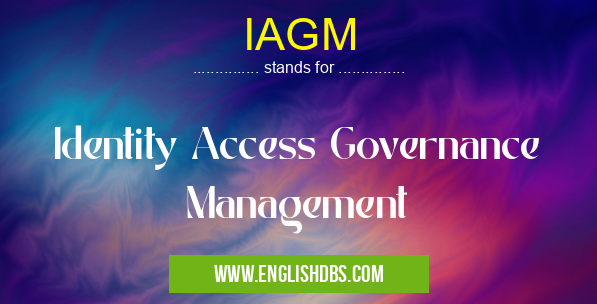What does IAGM mean in MANAGEMENT
IAGM has become increasingly important in today's digital landscape, where organizations face growing threats from cyberattacks and data breaches. By implementing an effective IAGM program, organizations can:

IAGM meaning in Management in Business
IAGM mostly used in an acronym Management in Category Business that means Identity Access Governance Management
Shorthand: IAGM,
Full Form: Identity Access Governance Management
For more information of "Identity Access Governance Management", see the section below.
» Business » Management
- Reduce security risks: Limit access to sensitive data and systems to authorized individuals, minimizing the potential for unauthorized access or misuse.
- Improve compliance: Meet regulatory and industry standards that mandate secure access management practices.
- Enhance efficiency: Streamline access provisioning and management processes, saving time and resources.
- Increase visibility and control: Gain a comprehensive view of user access patterns and permissions, enabling proactive risk management.
Identity Access Governance Management ( IAGM )
IAGM stands for Identity Access Governance Management, a comprehensive framework for managing and securing access to critical resources within an organization. It involves establishing policies, processes, and technologies to ensure that the right people have the right access to the right resources, at the right time, and for the right reasons.
Components of IAGM
IAGM encompasses a range of components, including:
- Identity management: Managing the creation, maintenance, and deactivation of user identities and attributes.
- Access management: Controlling who has access to what resources, and under what conditions.
- Governance: Establishing policies, processes, and roles for overseeing and enforcing access management practices.
- Monitoring and auditing: Continuously monitoring access activity and auditing compliance with policies.
Implementation
Implementing an IAGM program requires a strategic and phased approach, involving:
- Assessment: Identifying current access management practices and risks.
- Planning: Developing an IAGM roadmap and establishing policies and procedures.
- Implementation: Deploying the necessary technologies and implementing access management controls.
- Monitoring and maintenance: Regularly reviewing access patterns, auditing compliance, and making adjustments as needed.
Essential Questions and Answers on Identity Access Governance Management in "BUSINESS»MANAGEMENT"
What is Identity Access Governance Management (IAGM)?
IAGM is a framework that helps organizations manage the identities of users, their access to resources, and the governance of these identities and access privileges. It ensures that the right people have the right access to the right resources at the right time.
What are the benefits of IAGM?
IAGM offers numerous benefits, including improved security, compliance, operational efficiency, and cost reduction. It helps organizations prevent unauthorized access, meet regulatory requirements, automate identity and access management processes, and minimize the risk of security breaches.
What are the key components of IAGM?
IAGM comprises several essential components, such as identity management, access management, governance, and compliance. Identity management involves managing user identities, attributes, and relationships. Access management controls user access to resources and applications based on their roles and permissions. Governance ensures that IAGM processes align with organizational policies and regulations. Compliance verifies that IAGM practices meet industry standards and regulatory requirements.
How does IAGM differ from traditional identity management?
Traditional identity management focuses primarily on managing user identities and credentials. IAGM takes a holistic approach by considering not only identities but also access rights and governance. It enables organizations to gain a comprehensive view of user access and privileges, allowing for more granular control and enhanced security.
What are the best practices for implementing IAGM?
Implementing IAGM effectively requires following best practices such as defining clear policies and procedures, using automation tools, conducting regular audits, and training employees on identity and access management principles. It also involves integrating IAGM with existing IT systems and security measures to ensure seamless operation.
Final Words: IAGM is an essential component of a robust cybersecurity strategy. By empowering organizations to manage and control access to critical resources, IAGM helps protect data, reduce risks, and improve compliance. With the increasing adoption of cloud computing and remote work, IAGM is becoming even more critical for securing organizations in the digital age.
